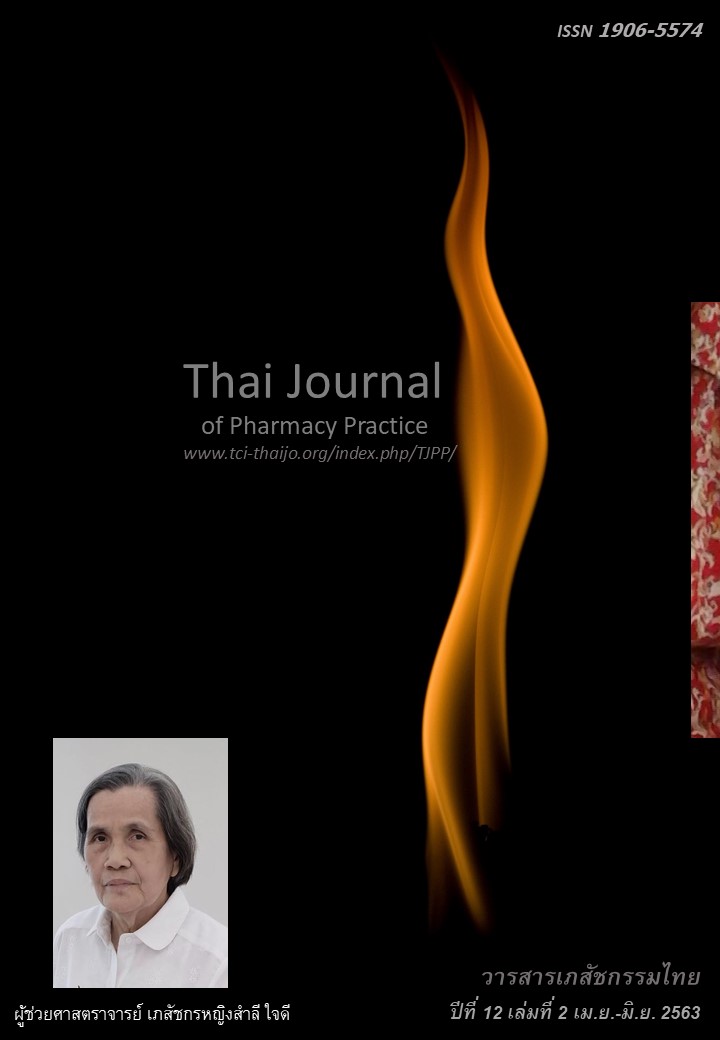การพัฒนาแบบวัดความแตกฉานทางสุขภาพสำหรับชาวไทยโดยประเมินจากทักษะที่สำคัญ
Main Article Content
บทคัดย่อ
วัตถุประสงค์: เพื่อพัฒนาแบบวัดความแตกฉานทางสุขภาพสำหรับชาวไทยโดยประเมินจากทักษะที่สำคัญ (Thai Health Literacy Assessment based on Skills: THLA-S) และหาเกณฑ์แปลผลระดับความแตกฉานทางสุขภาพ (health literacy: HL) ของแบบวัด วิธีการ: การพัฒนาแบบวัดประกอบด้วย 5 ขั้นตอน คือ 1) การวิเคราะห์ทักษะที่ประเมินโดยแบบวัด HLSI (Health Literacy Skills Instrument) ซึ่งเป็นต้นแบบ 2) การจัดทำแบบวัด THLA-S ฉบับเริ่มต้นที่วัดทักษะที่ใกล้เคียงกับ HLSI 3) การพิจารณาแบบวัดโดยผู้เชี่ยวชาญ 6 ท่านและการปรับปรุงตามข้อเสนอแนะ 4) การทดสอบความตรงและความเที่ยงในตัวอย่างขนาดใหญ่ในโรงพยาบาลศูนย์ โดยตัวอย่างเป็นผู้ป่วยนอกและญาติจำนวน 522 คนที่เลือกมาแบบตามสะดวก ตัวอย่างตอบแบบวัด THLA-S และแบบสอบถามที่ตัวบ่งชี้ระดับของ HL (การรับรู้ทักษะของตนในการทำกิจกรรมที่จำเป็นต่อการมี HL ความสามารถในการอ่านจาก cloze test คะแนนจากแบบคัดกรองผู้มี HL ไม่เพียงพอ และความสามารถในการใช้ฉลากโภชนาการ) และ THLA-N (Thai Health Literacy Assessment Using Nutrition Label) และ 5) การหาเกณฑ์คะแนนด้วยการวิเคราะห์โค้ง receiver operating characteristic (ROC) โดยใช้คะแนนจาก THLA-N เป็น gold standard ผลการวิจัย: แบบวัด THLA-S มีค่า Cronbach’s alpha เท่ากับ 0.81 แบบวัดมีความตรง เพราะ 1) ในการประเมินความสามารถของตนเองในการทำ 6 กิจกรรม (จากจำนวน 8 กิจกรรมที่จำเป็นต่อการมี HL ผู้ที่ตอบว่า ง่ายได้คะแนน THLA-S สูงกว่าผู้ที่ตอบว่ายาก 2) ผู้ที่มีระดับการศึกษาสูงกว่าได้คะแนน THLA-S มากกว่า 3) ความสัมพันธ์ของ THLA-S เป็นบวกและมีนัยสำคัญทางสถิติ (P<0.05) กับกับตัวชี้วัด HL ต่อไปนี้ การรับรู้ความสามารถของตนเองในการทำกิจกรรมที่จำเป็นต่อการมี HL ความสามารถในการอ่านจาก cloze test คะแนนจากแบบคัดกรองผู้มี HL ไม่เพียงพอ ความสามารถในการใช้ฉลากโภชนาการ และ THLA-N โดยมีค่าสัมประสิทธิ์สหสัมพันธ์ 0.34, 0.40, 0.16, 0.63 และ 0.61 ตามลำดับ การวิเคราะห์โค้ง ROC พบพื้นที่ใต้โค้ง ROC 0.84 คะแนน THLA-S ≤ 13 ถือว่ามี HL ไม่เพียงพอ ณ จุดตัดนี้ ได้ค่าความไว ร้อยละ 75.0 ค่าความจำเพาะ ร้อยละ 78.4 ค่า PPV ร้อยละ 79.12 ค่า NPV ร้อยละ 74.19 ค่า LR+ และค่า LR- ได้ค่า 3.47 และ 0.32 ตามลำดับ สรุป: แบบวัด THLA-S มีความตรง ความเที่ยง ความไว ความจำเพาะ และความสามารถในการจำแนกระดับ HL ได้ดีเป็นที่น่าพอใจ อย่างไรก็ตาม แบบวัดที่ได้นี้จำเป็นต้องพัฒนาต่อไป เพราะแบบวัดมีจำนวนคำถามมาก
Article Details
ผลการวิจัยและความคิดเห็นที่ปรากฏในบทความถือเป็นความคิดเห็นและอยู่ในความรับผิดชอบของผู้นิพนธ์ มิใช่ความเห็นหรือความรับผิดชอบของกองบรรณาธิการ หรือคณะเภสัชศาสตร์ มหาวิทยาลัยสงขลานครินทร์ ทั้งนี้ไม่รวมความผิดพลาดอันเกิดจากการพิมพ์ บทความที่ได้รับการเผยแพร่โดยวารสารเภสัชกรรมไทยถือเป็นสิทธิ์ของวารสารฯ
เอกสารอ้างอิง
2. Berkman ND, Sheridan SL, Donahue KE, Halpern DJ, Viera A, Crotty K, et al. Health literacy interventions and outcomes: an updated systematic review. Evidence reports/technology assessments No.199 [online]. 2011 [cited Feb 12, 2016]. Available from: www.ncbi.nlm.nih.gov/pubmed/23126607.
3. Berkman ND, Sheridan SL, Donahue KE, Halpern DJ, Crotty K. Low health literacy and health outcomes: an updated systematic review. Ann Intern Med 2011; 155: 97-107.
4. Cho YI, Lee SY, Arozullah AM, Crittenden KS. Effects of health literacy on health status and health service utilization amongst the elderly.Soc Sci Med 2008; 66: 1809-16.
5. Institute of Medicine. Health literacy: a prescription to end confusion. Washington DC: National Academies ; 2004.
6. Neilsen-Bohlman L, Panzer AM, Hamlin B, Kindig DA. Health literacy: a prescription to end confusion. Washington DC: The National Academies Press; 2004.
7. Baker DW. The meaning and the measure of health literacy. J Gen Intern Med. 2006; 21: 878-83.
8. Parker RM, Kindig DA. Beyond the Institute of medicine health literacy report: are the recommenda- tions being taken seriously. J Gen Intern Med 2006; 21: 891-2.
9. McCormack L, Bann C, Squiers L, Berkman ND, Squire C, Schillinger D, et al. Measuring health literacy: a pilot study of a new skills-based instru- ment. J Health Commun 2010; 5 Suppl 2: S51-71.
10. Ungsinun I. Creating and developing of Thai health literacy scales [online]. 2017 [cited Jun 16, 2018]. Available from: bsris.swu.ac.th/upload/268335.pdf.
11. Bangonsri J. Validity and reliability of the Thai vertion of health literacy screening tools for patients at Srinagarind Hospital, Khon Kaen, Thailand [master thesis]. Khon Kaen University; 2013.
12. Phantong W. Development of the Thai Health Literacy Assessment using Word List (THLA-W) [minor thesis]. Songkhla: Prince of Songkla Univer- sity; 2016.
13. Haun JN, Valerio MA, Mccormack LA, Sørensen K, Paasche-Orlow MK. Health literacy measurement: an inventory and descriptive summary of 51 instru- ments. J Health Commun 2014; 19: 302-33.
14. Janchooto P. Development of the Thai Health Literacy Assessment Using Word List with Extended Questions to Test Comprehension (THLA -W+): Testing in Sadao Hospital [minor Thesis]. Songkhla: Prince of Songkla University; 2017.
15. Lee SY, Bender DE, Ruiz RE, Cho YI. Development of an easy-to-use Spanish health literacy test. Health Serv Res. 2006; 41: 1392-412.
16. Na Pattalung P. Development of a Health Literacy Screener for Thais Based on the Approach of the Newest Vital Sign [master thesis]. Songkhla: Prince of Songkla University; 2018.
17. Weiss BD, Mays MZ, Martz W, Casto KM, DeWalt DA, Pignone MP, et al. Quick assessment of literacy in primary care: the newest vital sign. Ann Fam Med 2005; 3: 514-22.
18. Chew LD, Bradley KA, Boyko EJ. Brief questions to identify patients with inadequate health literacy. Fam Med 2004; 36: 588-94.
19. Willis GB, Royston P, Bercini D. The use of verbal report methods in the development and testing of survey questionnaires. Appl Cogn Psychol 1991; 5: 251-67
20. Faul GF, Erdfelder E, Buchner A, Lang AG. Statistical power analyses using G*Power 3.1: tests for correlation and regression analyses. Behav Res Methods 2009; 41: 1149-60.
21. Youden WJ. Index for rating diagnostic tests. Cancer 1950;3:32-5.
22. Zhou XH, Obuchowski NA, Obuschowski DM. Statistical methods in diagnostic medicine. New York: Wiley & Sons; 2002.
23. Swets JA. Measuring the accuracy of diagnostic systems. Science 1988; 240: 1285-93.
24. Jaeschke R, Guyatt GH, Sackett DL. Users' guides to the medical literature. III. How to use an article about a diagnostic test. A. Are the results of the study valid? Evidence-based medicine working group. JAMA 1994; 271: 389-91.
25. Feise RJ, Michael MJ. Functional rating index: a new valid and reliable instrument to measure the magnitude of clinical change in spinal conditions. Spine 2001; 26: 78-86.


